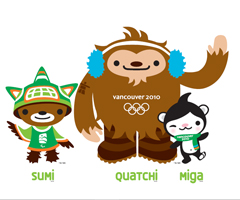Recent stories about the Vancouver Olympics and the role the federal government is playing are troubling.
Organizers of these Games constantly state that Aboriginal participation is unprecedented, but even Tewanee Joseph, CEO of Four Host First Nations—the organization that is the bridge between organizers and the community—admits he can’t name one Aboriginal athlete on our Olympic teams—winter or summer. If there are 200 athletes on the team to these Games, in terms of population ratios, six or seven should be Aboriginal.
Other issues to think about:
VANOC—the Vancouver Olympic Committee—asked the City of Vancouver for an injunction against the planned Feb. 14 women’s march on East Hastings Street. Every year people march on Valentine’s Day to remember the missing and murdered women of the city’s eastside, and to bring attention to ongoing issues of violence against Aboriginal women. VANOC said the march would cause traffic jams. Vancouver disallowed the injunction and the march will proceed.
Cowichan First Nation knitters had offered to supply their famous and beautiful hand-knit sweaters as an official sweater for the Games. VANOC turned down them down. This fall The Bay, an official sponsor, came out with $350 sweaters copied from traditional Cowichan designs. The nation luckily took the organizing committee to task and settled, but imagine the economic benefits—not to mention the pride—had VANOC gone with First Nation knitters.
Mi’kmaw Children’s Se’t A’newey Performance Choir say that in 2007 Premier Gordon Campbell twice invited them to sing at the opening ceremonies. This fall VANOC told them they were not on the program, and the premier had nothing to do with the opening ceremonies. They were then allowed to sing at the Aboriginal Pavilion at the Queen Elizabeth Theatre during Newfoundland and Labrador Day, but proudly replied that they weren’t interested in "playing second fiddle."
The Aboriginal Pavilion at the Olympics is not in the Queen Elizabeth Theatre, but rather is a temporary tent in the theatre’s parking lot.
There are no plans to ensure that Aboriginal youth have access to Olympic facilities. With the exception of the First Nations Snowboarding Team, an initiative of the Squamish First Nation, and "Chill Out"—a snowboarding program for inner-city youth started by Metis, not VANOC—there are no other programs in the 22 sports for Aboriginal youth to access.
Participants in the Olympic Indigenous Youth Gathering from Jan. 30-Feb. 14 were asked on the VANOC website, "Want to be part of the Olympic Games?"—yet are sent home the day after Olympic competition begins on Feb. 13. They had to send a photo of themselves in regalia, not 21st century clothing, and must be able to dance, drum, take instruction and perform for an international audience. They must "volunteer" for all performances and can be sent home for even talking to the media should they have a problem with arrangements, such as "dorm-style accommodations" during the H1N1 pandemic, or other restrictions. Such restrictions include having no rights to their own image, or creative work, so if the youth are performing in the opening ceremonies, which bring in revenues of hundreds of millions of dollars, they have no rights to claim a single penny. If their image, artwork, or written work appear in the "official" books of the Olympics, they have no rights to any of the profit generated by the books. If they create a song, dance or piece of visual art while at the Youth Gathering, VANOC holds 100% of the rights to all of these creations in perpetuity and does not have to pay the writers, dancers or musicians anything.
"Authentic Aboriginal Designs" on t-shirts, scarves, toques, vests and other memorabilia is mainly made in China, Bangladesh, Haiti, Honduras, and India. Aboriginal artists who wanted their work considered had to agree to allow VANOC to change their work should they so desire . . . and the Games have not yet begun.
Laura Robinson is a former member of Canada’s national cycling team and will cover the 2010 Winter Olympics for the Anishinabek News.
For more on the subject, see Native Leaders, Youth Target Olympics and Rebranding Natives at 2010 Olympics.
Below: The 2010 Olympics mascots.


No comments:
Post a Comment
Note: Only a member of this blog may post a comment.